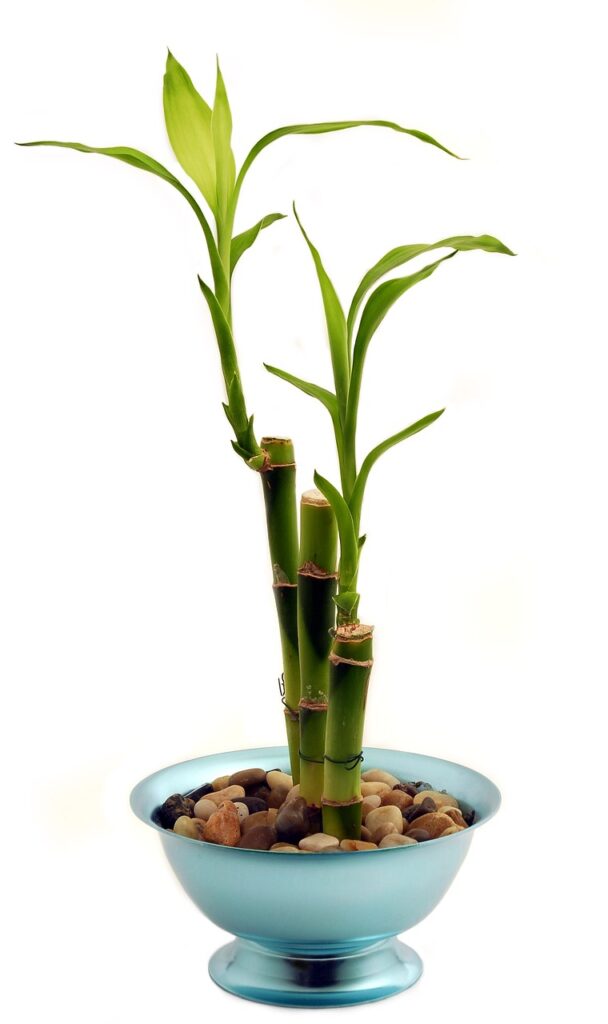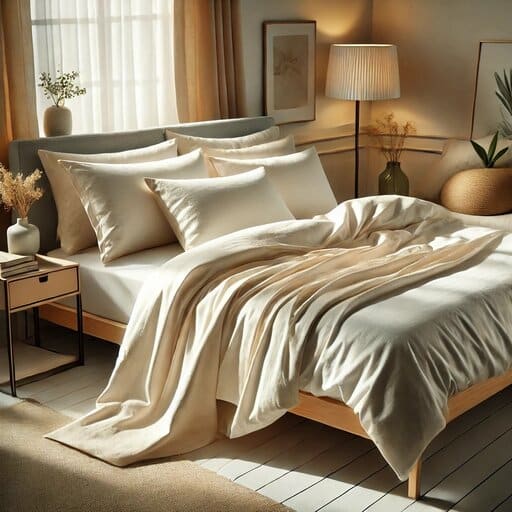Finding bedding that feels great and stays true to your values isn’t always simple. Some fabrics are breathable but not sustainable. Others are labeled “eco-friendly” but don’t offer any real proof.
That’s where eco-friendly bamboo bedding comes in—it’s soft, cool, and can be a more planet-friendly choice if made the right way.
Covered Below
What Counts as Bamboo Bedding?
When you hear “bamboo bedding,” your first thought might be sheets—but there’s more to it. Here’s what usually falls under this category:
- Fitted and flat sheets
- Pillowcases
- Duvet covers
- Comforters or quilts filled with bamboo fiber
- Mattress toppers with bamboo blends
Most products use bamboo fabric on the outside. Some also use bamboo filling to help with breathability and moisture control.
Key Benefits of Bamboo Bedding
Bamboo bedding has gained attention for good reason. Here’s why many people are making the switch:
“I switched to bamboo sheets and stopped waking up sweaty every night. They’re soft and cool without feeling slippery.”
- Soft and breathable – The fabric feels light and smooth, helping airflow and keeping you from overheating.
- Wicks away moisture – If you deal with night sweats, bamboo helps keep you dry and comfortable.
- Gentle on sensitive skin – Bamboo resists dust mites and allergens, making it a good pick for allergy-prone sleepers.
- Less odor buildup – Its breathability and quick-drying surface help keep that musty smell away.
- Grows sustainably – Bamboo grows fast and doesn’t need much water, fertilizer, or pesticides.

What Makes Bamboo Bedding Eco-Friendly?
Bamboo is a renewable plant, but how it’s turned into fabric really determines how eco-friendly the end product is.
Closed-loop processing is what makes bamboo lyocell stand out. It reuses water instead of dumping it out, and it keeps harmful chemicals from leaking into the environment. That means less waste, safer conditions for workers, and fewer resources used overall compared to older rayon methods.
While lyocell is often the most sustainable option, it can also be more expensive and harder to find than bamboo rayon or viscose.
Bamboo is a renewable plant, but how it’s turned into fabric really determines how eco-friendly the end product is.
- Bamboo Rayon or Viscose – This is common but involves heavy chemical processing. It’s not the worst, but it’s not the cleanest either.
- Bamboo Lyocell – A better option if you’re focused on sustainability. It’s made using a closed-loop system that reuses water and keeps waste low.
- Bamboo Linen – Processed mechanically without chemicals, but it’s rare and feels rougher.
Look for OEKO-TEX, GOTS, or FSC certifications—OEKO-TEX checks for chemicals that could irritate your skin, GOTS supports organic farming and ethical production, and FSC means the bamboo came from a forest that’s responsibly managed—they don’t mean everything, but they do show some level of care in how the product is made.
If a brand says “eco-friendly bamboo” without explaining the fabric type or how it’s made, be cautious. That kind of vague labeling can be a sign of greenwashing. The more specific they are, the more you can trust what you’re buying.
How to Choose Eco-Friendly Bamboo Bedding
Not all bamboo bedding is created equal. Here’s what to check before adding to cart:
Transparency – If the company shares info about their sourcing, processing, and sustainability efforts, that’s a good sign.
Fabric type – Bamboo lyocell is your best bet for lower-impact, chemical-free production.
Certifications – OEKO-TEX checks for chemicals you don’t want near your skin, and GOTS covers organic materials and ethical processing. If those labels are on the packaging, it’s usually a sign the brand has done a bit more than just slap on the word “green.”
Avoid blends – Bamboo mixed with polyester or microfiber loses breathability and can shed microplastics.
Quick Pros and Cons Table
| Feature | Bamboo Bedding | Cotton Bedding | Linen Bedding |
|---|---|---|---|
| Softness | Very soft | Varies | Crisp, softens with time |
| Breathability | Excellent | Good | Excellent |
| Eco-Friendliness | High (if lyocell) | Moderate (if organic) | High (flax linen) |
| Care Needs | Gentle care needed | Easy | Moderate |
| Price | $$–$$$ | $–$$$ | $$$ |
Who Should (and Shouldn’t) Buy Bamboo Bedding?
Good For:
- Hot sleepers or anyone dealing with night sweats
- People with sensitive skin or mild allergies
- Shoppers who want soft, breathable bedding
- Anyone looking for sustainable materials
Not Ideal For:
- Those who want wrinkle-free sheets
- People who prefer crisp cotton feel
- Anyone who doesn’t want to deal with special care routines
How to Care for Bamboo Bedding
Bamboo bedding can last several years with proper care—often as long as high-quality cotton or linen. Just skip the bleach and hot dryers—those tend to wear out the fabric faster.
Bamboo sheets don’t need complicated routines, but a bit of care helps them last longer.
- Wash with cold water on a gentle cycle
- Use a mild, fragrance-free detergent
- Avoid bleach and fabric softeners
- Air dry if possible, or use low heat in the dryer
- Don’t wash with rough items like towels or jeans
These steps help keep the fabric soft and prevent pilling or shrinkage.
End-of-Life and Biodegradability
Bamboo bedding made from 100% bamboo (not blended with synthetics) can break down naturally. Under composting conditions, it may biodegrade in a few months. Avoid bamboo-polyester blends if biodegradability is important to you.
Myths vs Facts
Myth: All bamboo sheets are eco-friendly.
Fact: Not true. Bamboo rayon and viscose are chemically processed. Bamboo lyocell is much cleaner.
Myth: Bamboo sheets don’t wrinkle.
Fact: They do, often more than cotton. That’s the trade-off for a softer feel.
Myth: Bamboo bedding is only for hot climates.
Fact: It’s breathable, but it also keeps warmth in cooler months.
All about BAMBOO with Lee
Frequently Asked Questions About Eco-Friendly Bamboo Bedding
- Is bamboo bedding environmentally friendly? Yes, especially when it’s made from bamboo lyocell or certified by OEKO-TEX, GOTS, or FSC. It combines comfort with a lower environmental footprint—just make sure to check how it’s processed.
- What is the downside to bamboo sheets? Bamboo sheets can wrinkle more than cotton and require gentle washing. They might not be the best pick for someone looking for crisp, low-maintenance bedding.
- How long does bamboo fabric take to biodegrade? Pure bamboo fabric can break down in a few months under the right composting conditions. Blended fabrics with synthetics will take much longer and may not fully decompose.
- Is bamboo fabric greenwashing? Not always. Some bamboo bedding is genuinely eco-friendly, especially when made from lyocell. Be cautious if the product lacks details about the fabric type or production method.
- Does bamboo fabric release microplastics? Only if it’s blended with synthetic fibers like polyester. 100% bamboo fabrics won’t shed microplastics during washing.
- Are bamboo sheets environmentally friendly? Yes—if they’re made responsibly. Bamboo grows quickly without pesticides, and bamboo lyocell uses cleaner production methods. Always check the label.
- Is bamboo more eco-friendly than cotton? In many cases, yes. Bamboo uses less water and fewer chemicals to grow, and lyocell production tends to be cleaner than conventional cotton processing.
- Are bamboo sheets worth it? They are if you value softness, breathability, and sustainable materials. While they need a little extra care, many people find them more comfortable than cotton.
- Can dust mites live in bamboo sheets? Bamboo fabric naturally resists dust mites and bacteria, which can be helpful for those with allergies.
- How do you wash bamboo sheets? Wash in cold water on a gentle cycle—nothing fancy. Just use a simple, fragrance-free detergent and skip anything harsh. Avoid bleach and fabric softener. Air drying is best, but you can also tumble dry on low heat.
Final Thoughts about Eco-Friendly Bamboo Bedding
Finding the right bedding isn’t just about comfort anymore. It’s about feeling good at night and knowing you made a choice that’s better for the planet too. That’s what eco-friendly bamboo bedding can give you.
It’s soft, breathable, and, when you choose bamboo lyocell, it’s made in a way that’s much easier on the environment. It feels good — and it feels good to know it’s a smarter choice.
If you’re ready to switch, check out my guide to eco-friendly bamboo sheets or take a look at how bamboo compares to other fabrics:
Good sleep and good choices really can go together.

Kristin is the founder of Eco Bamboo Living. She shares honest, research-backed guides and product reviews to help readers find bamboo products that are truly sustainable, practical, and worth bringing into their homes.

